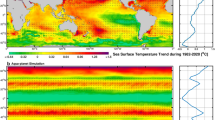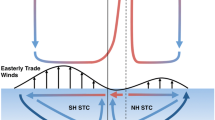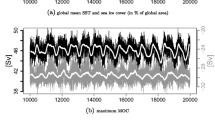Abstract
An aquaplanet atmospheric general circulation model (GCM) coupled to a mixed layer ocean is analyzed in terms of its polar amplified surface temperature response to a 2×CO2-like steady forcing and in terms of the phase space trajectory of the relaxation of a free perturbation to equilibrium. In earlier studies concerned with linear stability analysis of the same system we have shown that the least stable mode of the linearized surface budget operator has a polar amplified shape. We demonstrate that this shape of the least stable mode is responsible for the polar amplified shape of the response to a uniform forcing and for the manner in which the system relaxes back to equilibrium. Based on GCM and simple energy balance model results it is argued that the decay time-scale of this mode is determined by the sensitivity of the net top-of-atmosphere radiation to surface temperature while its shape (and thus the degree of polar amplification in a climate change experiment) is determined by the sensitivity of poleward heat transports to low- and high-latitude temperatures by the faster time-scale atmospheric dynamics. This implies that the underlying mechanisms for the polar amplification may be obscured when studying feedbacks during the slow evolution of climate change or considering only the new equilibrium state after introduction of a steady forcing.






Similar content being viewed by others
Notes
These are round numbers only. The changes in the low-latitude, high-latitude and uniform SST change experiments could also be read off as 0.3, −0.2 and 0.1 PW, respectively. In that case we would arrive at (γ1,γ2) = (0.2,0.1) PW/K. Since this has no impact on the qualitative conclusions reached in the following, we have chosen to use the parameter setting where the γ’s are equal.
References
ACIA (2004) Impacts of a warming Arctic: Arctic climate impact assessment. Cambridge University Press, Cambridge
Alexeev VA (2003) Sensitivity to CO2 doubling of an atmospheric GCM coupled to an oceanic mixed layer: a linear analysis. Clim Dyn 20:775–787
Alexeev VA, Langen PL, Bates JR (2005) Polar amplification of surface warming on an aquaplanet in "ghost forcing" experiments without sea ice feedbacks. Clim Dyn. doi:10.1007/s00382-005-0018-3
Arrhenius S (1896) On the influence of carbonic acid in the air upon the temperature of the ground. Phil Mag 41:237–276
Boer GJ (1995) Some dynamical consequences of greenhouse gas warming. Atmos Ocean 33:731–751
Budyko M (1969) The effect of solar radiation variations on the climate of the Earth. Tellus 21(5):611–619
Caballero R, Langen PL (2005) The dynamic range of poleward energy transport in an atmospheric general circulation model. Geophys Res Lett 32:L02705. doi:10.1029/2004GL021581
Cai M (2005) Dynamical amplification of polar warming. Geophys Res Lett 32:L22710. doi:10.1029/2005GL024481
Cai M (2006) Dynamical greenhouse-plus feedback and polar warming amplification. Part I: a dry radiative-transportive climate model. Clim Dyn 26:661–675
Colman R (2002) Geographical contributions to global climate sensitivity in a general circulation model. Glob Planet Change 32:211–243
Graversen RG (2006) Do changes in the midlatitude circulation have any impact on the Arctic surface air temperature trend? J Clim 19:5422–5438
Hall A (2004) The role of surface albedo feedback in climate. J Clim 17:1550–1568
Hall A, Qu X (2006) Using the current seasonal cycle to constrain snow albedo feedback in future climate change. Geophys Res Lett 33:L03502. doi:10.1029/2005GL025127
Hansen J, Sato M, Ruedy R, Nazarenko L, Lacis A, Schmidt GA, Russell G, Aleinov I, Bauer M, Bauer S, Bell N, Cairns B, Canuto V, Chandler M, Cheng Y, Del Genio A, Faluvegi G, Fleming E, Friend A, Hall T, Jackman C, Kelley M, Kiang N, Koch D, Lean J, Lerner J, Lo K, Menon S, Miller R, Minnis P, Novakov T, Oinas V, Perlwitz J, Perlwitz J, Rind D, Romanou A, Shindell D, Stone P, Sun S, Tausnev N, Thresher D, Wielicki B, Wong T, Yao M, Zhang S (2006) Efficacy of climate forcings. J Geophys Res 110(D18104)
Holland MM, Bitz CM (2003) Polar amplification of climate change in coupled models. Clim Dyn 21:221–232
Hoskins BJ, Karoly DJ (1981) The steady linear response of a spherical atmosphere to thermal and orographic forcing. J Atmos Sci 38:1179–1196
Kiehl JT, Hack JJ, Bonan GB, Boville BA, Briegleb BP, Williamson DL, Rasch PJ (1996) Description of the NCAR Community Climate Model (CCM3). Technical Report TN-420, CGD, National Center for Atmospheric Research
Langen PL, Alexeev VA (2004) Multiple equilibria and asymmetric climates in the CCM3 coupled to an oceanic mixed layer with thermodynamic sea ice. Geophys Res Lett 31. doi: 10.1029/2003GL019039
Langen PL, Alexeev VA (2005) Estimating 2 × CO2 warming in an aquaplanet GCM using the fluctuation–dissipation theorem. Geophys Res Lett 32. doi: 10.1029/2005GL024136
Manabe S, Wetherald RT (1980) On the distribution of climate change resulting from an increase in the CO2 content of the atmosphere. J Atmos Sci 37:99–118
Masson-Delmotte V, Kageyama M, Braconnot P, Charbit S, Krinner G, Ritz C, Guilyardi E, Jouzel J, Abe-Ouchi A, Crucifix M, Gladstone RM, Hewitt CD, Kitoh A, LeGrande AN, Marti O, Merkel U, Motoi T, Ohgaito R, Otto-Bliesner B, Peltier WR, Ross I, Valdes PJ, Vettoretti G, Weber SL, Wolk F, Yu Y (2006) Past and future polar amplification of climate change: climate model intercomparisons and ice-core constraints. Clim Dyn 26:513–529
North GR (1975) Theory of energy-balance climate models. J Atmos Sci 32:2033–2043
Qu X, Hall A (2006) Assessing snow albedo feedback in simulated climate change. J Clim 19:2617–2630
Rodgers KB, Lohmann G, Lorenz S, Schneider R, Henderson GM (2003) A tropical mechanism for Northern Hemisphere deglaciation. Geochem Geophys Geosys 4(5):1046. doi:10.1029/2003GC000508
Schneider EK, Lindzen RS, Kirtman BP (1997) A tropical influence on global climate. J Atmos Sci 54:1349–1358
Schneider EK, Kirtman BP, Lindzen RS (1999) Tropospheric water vapor and climate sensitivity. J Atmos Sci 56:1649–1658
Sellers WD (1969) A global climatic model based on the energy balance of the Earth–atmosphere system. J Appl Meteor 8:392–400
Shine KP, Cook J, Highwood EJ, Joshi MM (2003) An alternative to radiative forcing for estimating the relative importance of climate change mechanisms. Geophys Res Lett 30(20):2047
Sluijs A, Schouten S, Pagani M, Woltering M, Brinkhuis H, Damsté JSS, Dickens GR, Huber M, Reichart G-J, Stein R, Matthiessen J, Lourens LJ, Pedentchouk N, Backman J, Moran K, the Expedition 302 Scientists (2006) Subtropical Arctic Ocean temperatures during the Palaeocene/Eocene thermal maximum. Nature 441:610–613
Soden BJ, Broccoli AJ, Hemler RS (2004) On the use of cloud forcing to estimate cloud feedback. J Clim 17:3661–3665
Solomon A (2006) Impact of latent heat release on polar climate. Geophys Res Lett 33:L07716. doi:10.1029/2005GL025607
Wallace JM, Gutzler DS (1981) Teleconnections in the geopotential height field during the Northern Hemisphere winter. Mon Weather Rev 109:785–812
Weaver CP (2003) Efficiency of storm tracks an important climate parameter? The role of cloud radiative forcing in poleward heat transport. J Geophys Res 108
Winton M (2006) Amplified Arctic climate change: What does surface albedo feedback have to do with it? Geophys Res Lett 33:L03701. doi:10.1029/2005GL025244
Zachos JC, Pagani M, Sloan LC, Thomas E, Billups K (2001) Trends, rhythms and aberrations in global climate 65 Ma to present. Science 292:686–693
Acknowledgments
This research is supported by the Carlsberg Foundation and National Science Foundation Agreement No. ARC-0327664. This work was supported in part by a grant of HPC resources from the Arctic Region Supercomputing Center at the University of Alaska Fairbanks as part of the Department of Defense High Performance Computing Modernization Program. The suggestions by two anonymous reviewers substantially improved both the content and the clarity of the manuscript.
Author information
Authors and Affiliations
Corresponding author
Rights and permissions
About this article
Cite this article
Langen, P.L., Alexeev, V.A. Polar amplification as a preferred response in an idealized aquaplanet GCM. Clim Dyn 29, 305–317 (2007). https://doi.org/10.1007/s00382-006-0221-x
Received:
Accepted:
Published:
Issue Date:
DOI: https://doi.org/10.1007/s00382-006-0221-x




